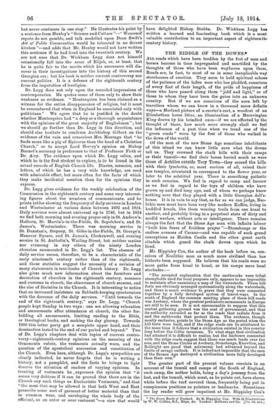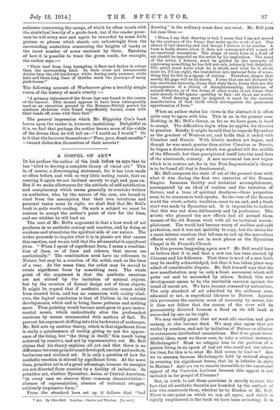THE RIDDLE OF THE DOWNS.* Au, roads which have been
trodden by the feet of men and horses become in time impregnated and sanctified by the thoughts of those who have been wayfarers upon them, Roads are, in fact, to most of us in some inexplicable way storehouses of emotion. They seem to hold spiritual echoes of the patience of the laden man who has plodded, conscious of every foot of their length, of the pride of happiness of those who have passed along them " jolif and light," or of
those to whom they have been the gates into an unknown country. But if we are conscious of the aura left by
travellers whom we can know in a thousand more definite ways—a Morland picture of a carrier's cart, a woodcut of an Elizabethan horse litter, an illumination of a Merovingian King drawn by his brindled oxen—if we are affected by the thought of these, how much more strongly shall we feel the influence of a past time when we tread one of the " green roads " worn by the feet of those who walked in the dawn of the world.
Of the men of the new Stone Age sometime inhabitants of this island we can know little save what the downs
tell us. They crowned the chalk bills with their camps or their tumuli—we find their bones buried much as were those of Achilles outside Troy Town—they scored the hills with their lynchetts, or, most curious of all, raised their sun temples, orientated to correspond to the flower year, or later to the solstitial year. There is something pathetic in such remains. We feel in regard to camp and barrow as we feel in regard to the toys of children who have grown up and died long ago, and of whom we perhaps know nothing save that they played with a little Georgian doll's-
house. It is in vain to say that, as far as we can judge, Neo- lithic men must have been very like modern Kaffirs, living in huddled kraals, like them wearing trails from one kraal to another, and probably living in a perpetual state of dirty and sordid warfare, without arts or intelligence. There remains always the fact that the Stone Age man with infinite labour " built him lanes of fruitless prayer "—Stonehenge or the endless avenues of Carnac—and was capable of such grand conceptions as Maiden Castle and the other great earth citadels which guard the chalk downs upon which he lived.
Mr. Hippisley Cox, the author of the book before us, con- ceives of Neolithic man as much more civilized than has hitherto been supposed. He believes that his roads were no mere paths from kraal to kraal, or his camps more local stockades :—
" The accepted explanation that the earthworks were tribal strongholds used for local purposes only, appears to me impossible to maintain after examining a map of the watersheds. These hill forts are obviously arranged systematically along the watersheds, and there is much evidence to prove that they were connected together by a fully developed system of travel-ways. In the south of England the common meeting place of these hill roads was Avebury, where the greatest prehistoric monuments in Europe are still to be seen. It is not unreasonable to suppose that this central gathering ground was the seat of government, and that its authority extended as far as the roads that radiate from it and the earthworks that protect them. The evidence, though mostly exclusive, points to the Stone Age as the period when the hill forts were built, and if the ridge roads can be attributed to the same time it follows that a civilization existed in this country long before the Celtic invasions. To what stage that civilization had attained it is difficult to realize, but the harbours connected with the ridge roads suggest that there was much trade over the seas, and the Stone Circles at Avebury, Stonehenge, Knowlton, and Rollright are proof that astronomy had advanced beyond the limits of savage outlook. It is indeed not impossible that the men of the Bronze Age destroyed a civilization more fully developed than their own."
The greater part of the present volume consists in an account of the tumuli and camps of the South of England, each camp, the author holds, being a day's journey from the last, and the tumuli, which must, as he points out, have shown white before the turf covered them, frequently being put in conspicuous positions as pointers or landmarks. Sometimes the lay reader will grow impatient at Mr. Hippisley Cox's
• The Green Roads of England. By B. Hippisley Cox. With 24 Illustrations by W. W. Collins, ELL, Maps, &c. London : Methuen and Co. [IQs. 63. net]
reticence concerning the camps, of which he often treats with the statistical brevity of a guide-book, but if the reader perse- vere he will every now and again be rewarded by some little picture or phrase which stands out refreshingly from the surrounding austerities concerning the heights of banks or the exact number of acres enclosed by them. Speaking of how it is possible to trace the green roads, for example, the author says :—
• "Their turf from long trampling is finer and darker in colour than the surrounding land. In their close soil innumerable daisies turn the old trackways white during early summer, while here and there long lines of thistles mark the journeys of many pack-horses."
The following account of Warbarrow gives a terribly simple vision of the history of man's cruelty :- "A primary intermentof the Stone Age was found in the centre of the barrow. This mound appears to have been subsequently used as an execution ground in the Romano-British period, for nineteen skeletons were found superficially buried, some with their heads off, some with their feet."
The general impression which Mr. Hippisley Cox's book leaves upon the reader is, however, tantalizing. Delightful as it is, we feel that perhaps the author knows more of the riddle of the downs than he will tell us—" I could an I would." Or is it that the barrows themselves—" Poor, poor, dumb mouths" —cannot disburden themselves of their secrets ?











































 Previous page
Previous page